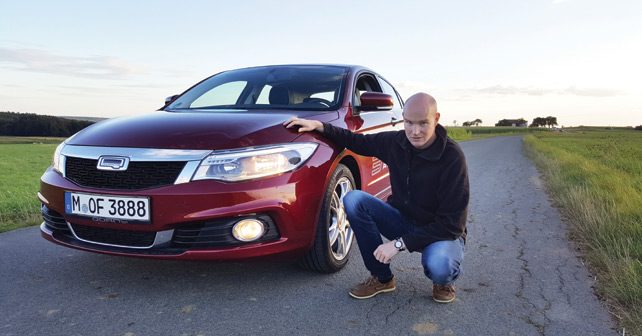
Jens says that the Chinese are finally coming, and they’re bringing the Germans with them.
A few years ago, Chinese carmakers were met with unbridled arrogance in export markets. But that was understandable since their offerings were often severely lacking – many of them were blatant rip-offs of Western or Japanese designs, and the technology under the skin was many a time severely lacking. The first two attempts in Europe – Landwind and Brilliance – received abysmal scores in crash testing, and the third one, an SUV by Shuanghuan, was kept off the market when BMW sued the importer for what was perceived to be a copy of the X5 (although the front end was actually taken from the Toyota Land Cruiser Prado). Many observers wrote the Chinese off altogether.
Then came a brand with the potential to change the perception. At the 2013 Geneva Auto Show, Qoros appeared on stage. A joint venture between Chery and investor Israel Corporation, it wedded German design and European engineering with ‘Shanghai spirit.’ The design department was led by former Mini chief designer, Gert Hildebrand, engineering was handled by a strong internal team, as well as industry leaders like Magna Steyr, AVL List, Mahle, Bosch, and Continental.
While Qoros got a lot of attention in the media, the company hasn’t performed well in the marketplace. Sales have picked up slowly, and their cars are rarely seen on the road in China. And while Qoros was hoping to expand beyond China, the assault on export markets has been put on hold. But I was lucky enough to get a few days behind the wheel of a Qoros 3 Sedan and a Qoros 3 Hatch near the company’s Munich headquarters, where some of its design and marketing staff are located.
Needless to say, I put both models through their paces – including top-speed Autobahn driving and a challenging loop in the ‘Switzerland of Franconia,’ as the particularly charming hills near my German home base are called. What struck me first is the clean and contemporary design. The cars look solid, sporty, and high quality. And this impression carries on inside, as the controls and switches feel expensive – while the touch screen monitors add a futuristic touch, as they allow swiping. And there’s a perfectly located charging spot for your iPhone.
My first leg took me 200 kilometres on the Autobahn, and the Qoros is extremely well isolated – road, wind and engine noise are kept at an absolute minimum. Considering its relatively compact size, the Qoros is a supremely comfortable and well-balanced high-speed cruiser. The 1.6-litre four sends 156 horsepower to the front wheels through a six-speed automatic transmission. The engine is as quiet as it is eager to perform, the car tops out at over 210km/h – and the car feels absolutely stable at that speed.
On twisty country roads, the Qoros 3 is sure-footed and it can be positioned with precision – but it isn’t as agile as, say, a VW Golf GTI. This sedan is on the comfortable side – sporty versions could come later. Clearly, this is the best Chinese car on the market, and its Germanness shines through. But do the Chinese customers know it?
Qoros’ recipe is interesting enough to be copied by other Chinese carmakers. The foremost of them is Borgward, a long-forgotten German brand that folded in 1961 – but returned at the 2015 Frankfurt Auto Show. A subsidiary of the Beijing truck maker Foton, Borgward, aims at the premium segment – a notch above Qoros – with a range of high-powered, hybridised SUVs.
Borgward plays the German card with a presence in Stuttgart, and a management roster recruited from several German carmakers. And this strategy seems to be paying off. Mostly by playing up its German heritage, Borgward is off to a remarkably successful launch – and its sales numbers are growing strongly despite the relatively high price point. The irony is that Borgward’s current line-up wasn’t even supposed to be marketed under the German nameplate. The decision – and the acquisition of the name – came late in the development process. It’ll be the next generation of vehicles, designed by the new chief designer Anders Warming (of BMW and Mini fame), which will actually deliver the German qualities that the brand is touting.
Meanwhile, Geely is preparing the launch of a new sub-brand positioned between its main brand and its upscale daughter Volvo. Details are scarce, but we suspect a healthy dose of German spirit and technology to be instilled in those cars as well. Count on Geely to tout this aspect in its marketing strategy.
Qoros aims to counter the assault with cutting-edge technology. While the brand is working on full electrics, it continues to push for advances in the internal combustion engine. Qoros is working on a camshaft-free engine, with a lot more power and efficiency, as well as massive packaging advantages. One of the most interesting things about it is that the technology is co-developed with supercar maker Koenigsegg. As everyone else is becoming German, it wouldn’t hurt to add a few Swedish genes to the pool.
At some point down the road, the Chinese will focus on the Indian market as well – and the local industry needs to be prepared.
























Write your Comment